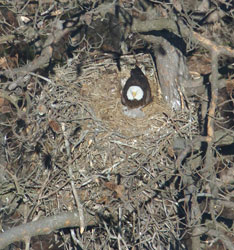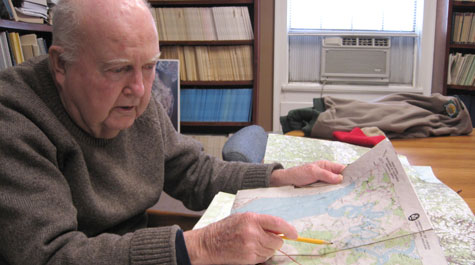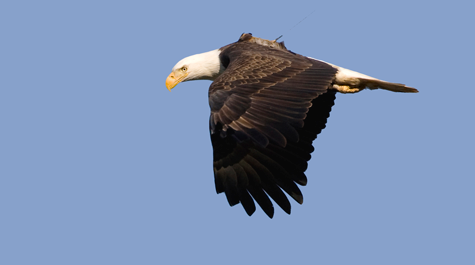Sex, violence, airplanes and the comeback of the national bird
Mitchell Byrd began studying bald eagles in the dark, DDT-haunted days, a time in which fieldwork included picking up poisoned birds lying on the ground under their nests.
Things have changed since the 1970s. The bald eagle has made a triumphant return to the Chesapeake Bay and its tributaries. The birds are healthy and the population is, too, having reached a point at which Byrd and his colleagues at the Center for Conservation Biology have begun to study the sociology of the national bird. Revelations from the population density have prompted scientists to start writing a new chapter in the natural history of the great birds, and it’s a chapter punctuated by mystery and a surprising amount of sex and violence.
Byrd has seen the evolution of an entire arsenal of high-tech tools studying eagles. The CCB captures the birds (sometimes using remotely triggered rocket nets) to fit them with lightweight transmitters, and then track their movements via satellite, assembling vast amounts of metadata on eagle movements. Videocameras record the nesting and chick-raising behavior of eagle parents as well as challenges and disruptions to their family life.
Even with all the high-tech assistance, the cornerstone of the CCB’s eagle research is comparatively old-school. Each spring, they fly low over nests and count the eagles, the eggs and the chicks. Spring is when the thoughts of eagles turn lightly to the weighty business of nesting. For the past 23 years, Byrd has been part of the same three-man team that flies just above treetop height, peering into eagles nest. He joins Bryan Watts, director of the CCB and a former fighter pilot who answers to Captain Fuzzzo. (The middle “z,” he says, is silent.)
After more than 20 years, Watts and Capt. Fuzzzo are the “new guys” on the census flights. Byrd joined William & Mary’s Department of Biology in 1956 and has been doing the census flights each year since 1977.
“I started this because the Endangered Species Act of 1973 had been enacted and the Department of Game and Inland Fisheries was interested in starting some programs involving some of the endangered species in Virginia,” Byrd said. “They asked me if I would take over these projects. One of them was bald eagles, one was on red-cockaded woodpeckers, and one was a program to try to re-introduce peregrine falcons to the state.”
 DDT, implicated in the decline of both peregrines and bald eagles, was banned in 1972. Today, the DDT has been flushed from the ecosystem, but there are other challenges out there for eagle families. At the top of the slate are threats from human development.
DDT, implicated in the decline of both peregrines and bald eagles, was banned in 1972. Today, the DDT has been flushed from the ecosystem, but there are other challenges out there for eagle families. At the top of the slate are threats from human development.
The removal of the bird from the federal Endangered Species List created some concern about human encroachment on eagle nesting sites, but Byrd says the eagles still have legal protection under the federal Bald and Golden Eagle Protection Act of 1940, which prohibits harming the birds or disturbing their nesting activities. Byrd explained that the feds may or may not use the Eagle Protection Act to deliver the same legal safeguards to nest areas that came along with the Endangered Species Act. He added that one bright spot in the consideration of the size of buffer zones is that today’s eagles aren’t as bothered by human presence as their ancestors.
“Back in the ’60s, eagles were very, very sensitive to disruption. All you had to do was walk by a nest, and they’d abandon it. I think there was something inherent in the DDT issue that made those birds wary like that,” he said. “It’s very difficult to make an eagle abandon a nest now. We have eagles nesting in people’s yards.”
Eagles have plenty of challenges from non-human sources, too. During the census flights, Byrd and his colleagues often see raccoons in eagle nests. Byrd said they always thought that the raccoons just moved into vacant nests, but he had to revise that hypothesis after visiting a nest up on the Rappahannock. He and a graduate student retrieved a tape from a video camera monitoring an eagle nest.
“There were eagle parts all over the ground from the two chicks,” Byrd recalled. “We looked at the video and we saw three big raccoons go up in the nest and just demolish those eagle chicks. So it might be that they’re actually displacing the eagles. We don’t really know.”
Raccoon marauders are bad enough, but a slasher film aimed at the wildlife market should cast a great horned owl as the villain. This species of owl, Byrd says, displays “a weird behavior,” a penchant for what a non-scientist might call indiscriminate slaughter. Byrd tells the stories: mass decapitations in a heron colony, a takeover of a peregrine falcon nest, which the owls had festooned with the mauled corpses of jackrabbits. Eagles are not exempt from owl attacks.
“There’ve been a fair amount of conflict between great horned owls and eagles. We’ve seen some fairly good-sized bald eagle chicks decapitated by great horned owls,” Byrd said. “It seems to be something that great horned owls like to do. Well, whether they like to do it or not, I don’t know, but they do it. They don’t usually eat them; they just take the heads off. ”
Despite the losses, the eagles of the Chesapeake region continue to expand in numbers and territory; Byrd says the growth rate is around 10 percent each year. The number of new questions about eagles seems to grow along with the population. For instance, the CCB saw a number of immature eagles nesting back in the ’90s, but they didn’t know if the birds were actually breeding. Today, there’s a glut of adult birds and the subadult eagles have been pushed out of the nesting pool. Another mystery surrounds a number of mature breeding pairs along the James River between Jamestown and Smithfield. These birds consistently breed much earlier than other eagles.
The scientists have found that bald eagles can get into romantic entanglements straight out of a trashy novel. The CCB has ample evidence of cheating wives and threesomes among our nation’s bird. Byrd knows of at least one bigamist—a male in New York who commuted between mates in two separate nests. He also has a story about an osprey with a midlife crisis and he believes that eagles might also “trade down” in age of mates.
Many people are eager to discover virtues in the national bird and so Byrd, Watts and other eagle scientists are often asked if the eagles mate for life.
“I tell them no,” Byrd said with a smile, “they take a break sometimes.”
This article appeared in the summer, 2014 issue of the William & Mary Alumni Magazine.
















